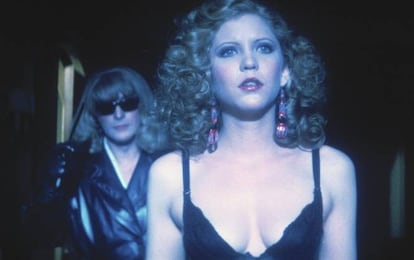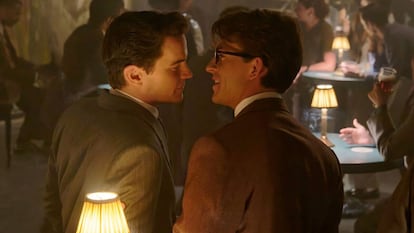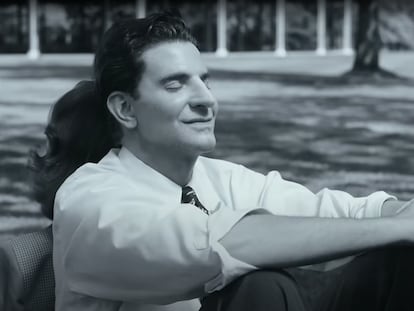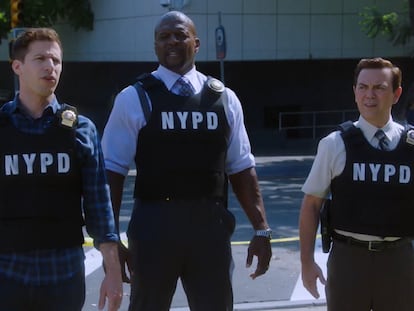The villain of the future is a queer man (and he’s fine with it)
‘Please! These gays, they’re trying to kill me!’ Jennifer Coolidge screams out in ‘The White Lotus.’ The line goes beyond the meme: for some time now, the LGBTQI+ community has been fiction’s favorite murderer

The second season of The White Lotus (2022) had almost as many viral moments as characters. But the single line “These gays, they’re trying to murder me” delivered by (spoiler alert) Jennifer Coolidge has undoubtedly become the most memorable. In a video interview, the actress told Variety that Mike White, writer and creator of the series, was always sure of the power of the sentence that came to destroy the friendly image that her character’s group of handsome friends conveyed throughout the plot. “Until then, they weren’t portrayed as malevolent,” Coolidge confesses.
Although the history of film and television is full of LGBTQI+ villains, the difference in this case is that Mike White himself belongs to the community, so as journalist Mike Harris says, “if you’re gay, it’s likely that you understood that you were on safe ground, and it was not a homophobic comment, but rather a joyous recovery of the idea of the gay monstrosity by the homophobes who guarded it for decades.” That is to say: it is no longer a question of simply putting up with the joke, but of creating one of your own and telling it.
“I think the key is in the ironic tone and the sense of humor that predominates in the series. It is not at all moralistic, nor does it present idealized characters that put good people above bad people, but instead inquires into the complexity of each and portrays their chiaroscuro. And, indeed, that affinity with the LGBTQI+ universe that can be seen in this point of view is also important. The public can understand the fact that gay murderers also end up being murdered as a game or a twist”, explains Francina Ribes Pericàs, author of Absence and excess: Lesbians and bisexuals in Hollywood cinema, a book in which she reflects on the archetype of the murderous lesbian or bisexual.
In the same way that the second season of The White Lotus laughs at homophobic stereotypes, it also plays with another misogynistic cliché: the “fag hag” (a woman who associates mostly or exclusively with gay and bisexual men) and who becomes a central character in the HBO series. “The maximum representation of equality in film and television began to arrive when the people in the community stopped being drawn by the pattern of clichés perpetuated for decades by Hollywood. Masterfully, and despite the fact that Coolidge’s character (Tanya) does not belong to the community, The White Lotus has turned Tanya into a gay icon. Perhaps to verbalize the boredom we feel that is nonsencically termed ‘gay fatigue,’” says Javier Parra, author of Scream Queer: LGBTQI+ representation in the horror films.

Ribes Pericàs says: “What I find most fascinating about this second season is how the fact of surrounding Tanya with gay men seems to take her to another dimension. Throughout the series, her character seems almost like a parody. She is a misunderstood misfit, but in this season for a moment she seems to find her place, surrounded by people who understand and appreciate her style, and her sensitivity, and let her shine.”
Bad and very proud
Throughout the history of cinema, queer people have on many occasions embodied an unspoken evil. The trans murderer played by Michael Caine in Brian de Palma’s Dressed to Kill (1980) was a particularly notorious case due to the discomfort it generated within the community — as well as among various feminist organizations due to its portrayal of violence against women. However, we are currently witnessing a boom in LGBTQI+ characters who go over to the dark side without wanting to be viewed in any other way or to hide their badness. Just as it is increasingly common to see women who love to be hated, the malevolent characters in the queer community now flaunt their evil openly. “A lot of the time, evil implies action and a certain subversive power that is given by the ability to rebel against an oppressive context,” says Francina Ribes Pericàs. “It may be important that film and television fiction offers alternative characters through whom traditionally oppressed groups, such as women or the LGBTQI+ community, can rebel and be represented as active, strong characters capable of getting away with all kinds of misdeeds.”
In the new season of the television anthology Feud (still pending release), Ryan Murphy will adapt the controversial 2021 book Capote’s Women, which describes the relationship between the writer Truman Capote (who was gay) and the women he referred to as his “swans,” as well as his betrayals of which they were victims. Tom Hollander, the well-mannered villain in the second season of The White Lotus, will also play the author of In Cold Blood (1965). Before that, we can enjoy the miniseries Fellow Travelers, in which the main character, played by Matt Bomer, is an opportunistic and ruthless man who does not hesitate to manipulate one of his lovers. No more Mr. Nice Gay, who dominated screen fiction starting with Will & Grace in 1998: now the villain enjoys being bad and doesn’t care that people despise him.

“In the early 1990s, associating queer characters with evil, like Sharon Stone’s in Basic Instinct (1992), or bloodsuckers like those from Interview with the Vampire (1994), might seem rather naive. Nowadays, associating evil with sexual orientation is a discourse that comes from only two paths: being a fascist or being unintelligent. And sometimes the two end up converging. I think that we are still in a transition process in which we have experienced how characters from the community were portrayed negatively, in tune with the tradition that anything that was not the heterosexual norm was bad,” says Parra. “As recent evil LGBTQI+ characters, I can think of some that have come from indie cinema, like the main character in Bliss (2019), but perhaps the strangest, sometimes even the most worrying thing, has to do with the explosion of the true crime genre, through which we have seen the conversion of serial killers into pop icons or rock stars. People like Jeffrey Dahmer, John Wayne Gacy, and Dennis Nielsen, homosexuals and serial killers, are the ultimate example of evil that transcends any orientation.”
Evil as the way in
There are those who believe that the bad guys are always the most interesting characters in history. Were they, perhaps, a way for the community to infiltrate the popular imagination and narratives where they were so often denied a space? “We have managed to infiltrate thanks to the reappropriation of negative clichés and gestures that are directly associated with being queer. Ask anyone in the community who saw The Little Mermaid [1989] or Sleeping Beauty [1959] as a child, and they will tell you that they loved Ursula [the marine villain inspired by Devine, John Waters’ muse, by the way] and Maleficent [a sorceress with the body of a Mugler model]. Villains have always been much more interesting than heroes. And now that the world is able to think about them with all the possible layers of irony and social criticism with which they have been built, their association with what is queer is more present than ever. Because the revolution will either be queer or there won’t be one,” says the author of Scream Queer.

In the introduction to the book The Celluloid Closet (1981), the historian Vito Russo said that “the big lie about gay men and women is that they don’t exist.” What’s more, the good thing about fiction that now includes villains who are happy and proud to be bad is that it reveals another big lie: the idea that LGBTQI+ people must always be good. In the end, these gays may try to kill you, but they’re not going to try to hide it anymore.
Sign up for our weekly newsletter to get more English-language news coverage from EL PAÍS USA Edition
Tu suscripción se está usando en otro dispositivo
¿Quieres añadir otro usuario a tu suscripción?
Si continúas leyendo en este dispositivo, no se podrá leer en el otro.
FlechaTu suscripción se está usando en otro dispositivo y solo puedes acceder a EL PAÍS desde un dispositivo a la vez.
Si quieres compartir tu cuenta, cambia tu suscripción a la modalidad Premium, así podrás añadir otro usuario. Cada uno accederá con su propia cuenta de email, lo que os permitirá personalizar vuestra experiencia en EL PAÍS.
¿Tienes una suscripción de empresa? Accede aquí para contratar más cuentas.
En el caso de no saber quién está usando tu cuenta, te recomendamos cambiar tu contraseña aquí.
Si decides continuar compartiendo tu cuenta, este mensaje se mostrará en tu dispositivo y en el de la otra persona que está usando tu cuenta de forma indefinida, afectando a tu experiencia de lectura. Puedes consultar aquí los términos y condiciones de la suscripción digital.
More information
Archived In
Últimas noticias
Most viewed
- Oona Chaplin: ‘I told James Cameron that I was living in a treehouse and starting a permaculture project with a friend’
- Reinhard Genzel, Nobel laureate in physics: ‘One-minute videos will never give you the truth’
- Sinaloa Cartel war is taking its toll on Los Chapitos
- Why the price of coffee has skyrocketed: from Brazilian plantations to specialty coffee houses
- Silver prices are going crazy: This is what’s fueling the rally











































